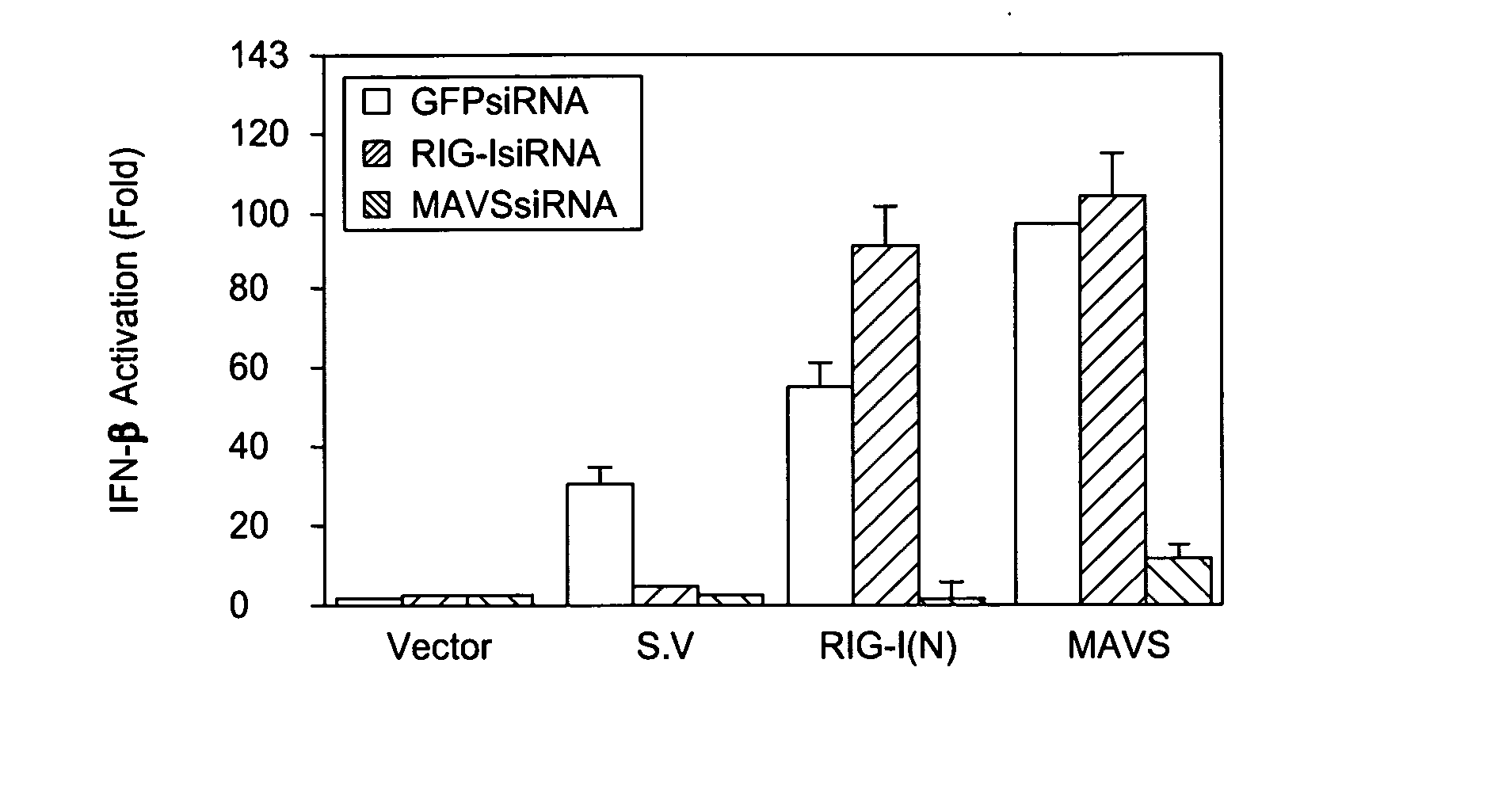MAVS in the prevention and treatment of viral diseases
a virus and vaccine technology, applied in the field of vaccine agents, can solve the problems of inability to understand the mechanism by which rig-i activates nf-b and irf3, and remain a major global health threat, and achieve the effect of high throughput screening
- Summary
- Abstract
- Description
- Claims
- Application Information
AI Technical Summary
Benefits of technology
Problems solved by technology
Method used
Image
Examples
example 1
[0104] Identification and Sequence Analysis of MAVS. To understand the signaling pathways required for the activation of NF-κB and IRF3 by viruses, proteins were identified that include CARD-like domains similar to those of RIG-I and its homologue MDA-5. A BLAST search with the first CARD-like domain of MDA-5 identified an uncharacterized protein KIAA1271, which contains a single CARD-like domain at the N-terminus. Interestingly, this protein was also identified as a putative NF-κB activator in a large-scale screening for proteins that can activate an NF-κB reporter when they are overexpressed (Matsuda et al., 2003). However, there was no further characterization of this protein concerning its domain structure, activity or biological function. The present invention includes the characterization of the function for this protein, and found that in addition to the N-terminal CARD-like domain, which is conserved from pufferfish to human (FIG. 1A-C), KIAA1271 also contains a proline-rich...
example 2
[0140] The Specific and Essential Role of MAVS in Antiviral Innate Immune Responses. The mitochondrial antiviral signaling protein (MAVS) mediates the activation of NF-κB and IRFs and the induction of interferons in response to viral infection. In vitro studies have also suggested that MAVS is required for interferon induction by cytosolic DNA, but the in vivo evidence is lacking. By generating MAVS-deficient mice, it is shown herein that loss of MAVS abolished viral induction of interferons and prevented the activation of NF-κB and IRF3 in multiple cell types, except plasmacytoid dendritic cells. However, MAVS was not required for interferon induction by cytosolic DNA or by Listeria monocytogenes. Mice lacking MAVS were viable and fertile, but they failed to induce interferons in response to poly(I:C) stimulation and were severely compromised in immune defense against viral infection. These results provide the in vivo evidence that the cytosolic viral signaling pathway through MAVS...
example 3
[0168] The Hepatitis C Virus Protease NS3 / 4A Cleaves MAVS off the Mitochondria to Evade Innate Immunity. Hepatitis C virus (HCV) is a global epidemic manifested mainly by chronic infection. One strategy that HCV employs to establish chronic infection is to use the viral serine protease NS3 / 4A to cleave some unknown cellular targets involved in innate immunity. Here it is shown that the target of NS3 / 4A is MAVS, a mitochondrial antiviral signaling protein that activates NF-κB and IRF3 to induce type-I interferons. NS3 / 4A cleaves MAVS at Cys-508, resulting in the dislocation of the N-terminal fragment of MAVS from the mitochondria. Remarkably, a point mutation of MAVS at Cys-508 renders MAVS resistant to cleavage by NS3 / 4A, thus maintaining the ability of MAVS to induce interferons in HCV replicon cells. NS3 / 4A binds to and co-localizes with MAVS in the mitochondrial membrane, and it can cleave MAVS directly in vitro. These results provide an example of host-pathogen interaction in wh...
PUM
| Property | Measurement | Unit |
|---|---|---|
| Affinity | aaaaa | aaaaa |
Abstract
Description
Claims
Application Information
 Login to View More
Login to View More - R&D
- Intellectual Property
- Life Sciences
- Materials
- Tech Scout
- Unparalleled Data Quality
- Higher Quality Content
- 60% Fewer Hallucinations
Browse by: Latest US Patents, China's latest patents, Technical Efficacy Thesaurus, Application Domain, Technology Topic, Popular Technical Reports.
© 2025 PatSnap. All rights reserved.Legal|Privacy policy|Modern Slavery Act Transparency Statement|Sitemap|About US| Contact US: help@patsnap.com



